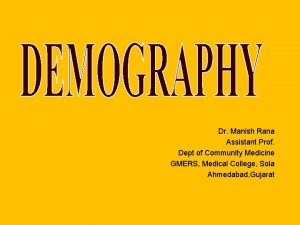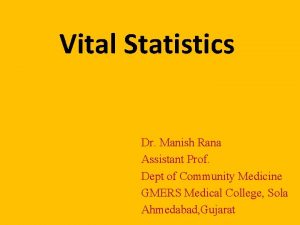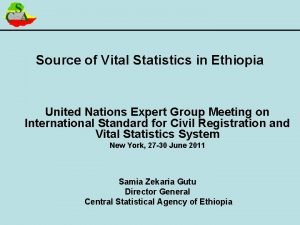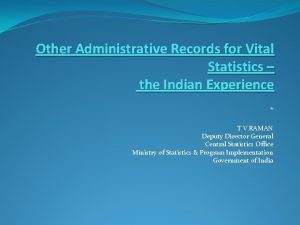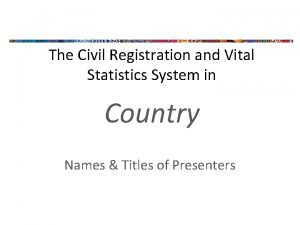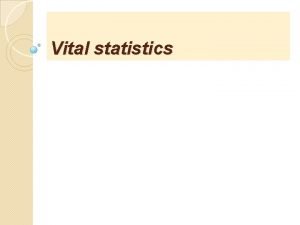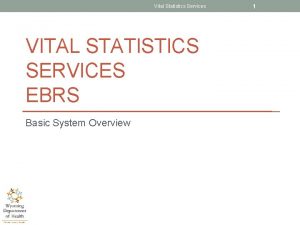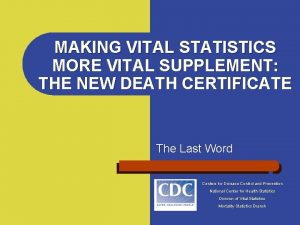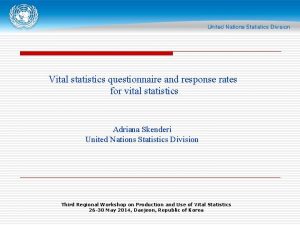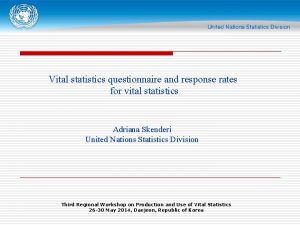Vital Statistics Dr Manish Rana Assistant Prof Dept



























- Slides: 27

Vital Statistics Dr. Manish Rana Assistant Prof. Dept of Community Medicine GMERS Medical College, Sola Ahmedabad, Gujarat

Learning Objectives What is Fertility Factors affecting fertility Fertility Related statistics

Fertility Actual bearing of child Also known as Natality Women's reproductive life: – 15 to 45 years (49 yrs) Reproductive life: – 30 years

Factors affecting fertility Higher fertility in India is attributable to – Universality of marriage Lower age at marriage Low level of literacy Poor level of living Limited use of contraceptives Traditional ways of life 1. Child is a gift of God 2. Desire for male child

Age at Marriage Lower age at marriage (17. 2 yrs) Higher age at marriage Average at marriage for females Prior to 1951: – 13 In 2006: – 20. 5 Child marriage restraint act Rural & urban differences

Duration of married life 1 -5 years of married life – 10 -25 % of births 5 – 15 years of life – 50 -55 % of births Target eligible couples in early years of married life

Nutrition Well fed societies & poorly fed societies Indirect relation between nutrition & Fertility

Spacing of children Spacing of 2 births by at least 3 years

Family Planning Better implementation of family planning programme Developed & developing countries

Other Factors Place of women in society Widow remarriages Breast feeding Custom & beliefs Industrialization & Urbanization Better health conditions Local community involvement

Fertility Related Statistics

Crude Birth Rate (CBR) Number of live births during the year × 1000 Estimated midyear population Total Rural Urban India 22. 5 24. 1 18. 3 Gujarat 22. 3 23. 8 19. 3 Kerala 14. 7 14. 6 14. 9

General Fertility Rate (GFR) No. of live births in an area in a year × Midyear female population age (15 – 44) in the same area in the same year If CBR is 25 what is the GFR? 1000

General Marital Fertility rate (GMFR) No. of live births in a year × Midyear married female population in the age group (15 – 44) in same year 1000

Age Specific Fertility Rate (ASFR) No. of live births in a particular age group Midyear female population of the same age Group in same year × 1000

Trends in ASFR 250 200 150 100 50 0 15 -19 20 -24 25 -29 30 -34 35 -39 40 -44 45 -49 NFHS 3 NFHS 2 NFHS 1

Age Specific Marital Fertility Rate (ASMFR) No. of live births in a particular age group Midyear married female population of the same age group in same year × 1000

Total Fertility Rate (TFR) 45 - 49 TFR = 5 × Σ ASFR 15 – 19 . 1000 TFR is the average no. of children a woman would have if she were to pass through her reproductive life bearing children at the same rates as women now in each group.

Trends in Total Fertility by Residence 4 3 NFHS 1 T 2 F R 1 0 NFHS 2 NFHS 3 Urban Rural Total Residence

Educational status (Years of schooling completed) TFR No education 3. 6 < 5 years 2. 5 5 -7 years 2. 5 8 -9 years 2. 2 10 -11 years 2. 1 12 years or > 1. 8

TFR & Wealth Index 4 3 TFR 2 1 0 Lowest Second Middle Wealth Index Fourth Highest

TFR & Religion. . . 0 1 2 TFR 3 4

TFR & Caste 4 T F R 3 2 1 0 SC ST Caste OBC Others Don’t Know

Total Marital Fertility Rate (TFR) 45 - 49 TMFR = 5 × Σ ASMFR 15 – 19 1000 .

Gross Reproduction Rate (GRR) 45 - 49 GRR = 5 × Σ ASFR for female live births 15 – 19 . 1000 Average no. of girls that would be born to woman if she experiences current fertility pattern throughout her reproductive life assuming no mortality

Net Reproduction Rate Average no. of daughters that a newborn girl will bear during her lifetime assuming fixed age specific fertility & mortality rates

Recap What is Fertility Factors affecting fertility Fertility Related statistics
 Dr manish rana
Dr manish rana Total fertility rate formula
Total fertility rate formula Manish gupta
Manish gupta 6e2111
6e2111 Manish chaudhary mathura
Manish chaudhary mathura Manish definition
Manish definition Aman chaudhary
Aman chaudhary Manish parashar utah
Manish parashar utah Pyloric stenosis
Pyloric stenosis Volúmenes pulmonares
Volúmenes pulmonares Vital statics
Vital statics Sources of vital statistics
Sources of vital statistics Vital statistics
Vital statistics List of vital statistics
List of vital statistics Introduction to statistics what is statistics
Introduction to statistics what is statistics Gome dept
Gome dept Hoe dept
Hoe dept Mn dept of education
Mn dept of education Pt dept logistik
Pt dept logistik Florida dept of agriculture and consumer services
Florida dept of agriculture and consumer services Hjdkdkd
Hjdkdkd Finance department organizational chart
Finance department organizational chart Dept ind onegov
Dept ind onegov Rowan county dss
Rowan county dss Horizontal
Horizontal Firefighter interview tips
Firefighter interview tips Department of finance and administration
Department of finance and administration Nys dept of homeland security
Nys dept of homeland security
